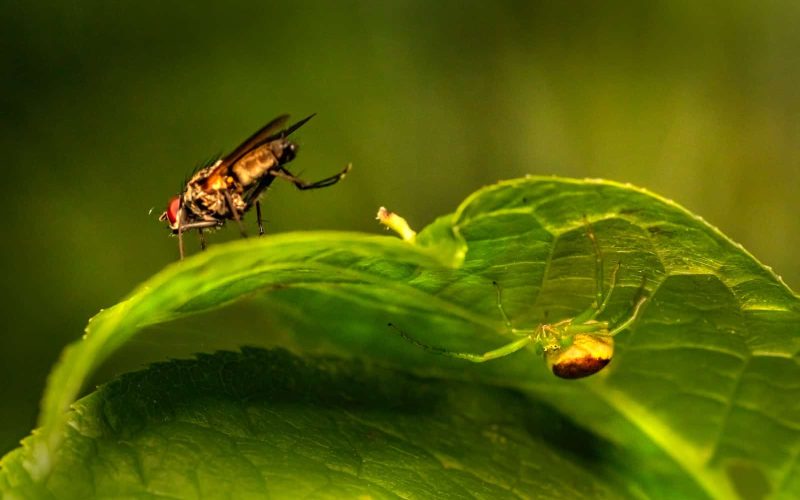You probably enjoy having houseplants in your home because they’re beautiful, but you may be dealing with some nasty houseplant pests if they’re not thriving the way you expect them to.
The good news is that these houseplant pests are relatively easy to eliminate.
They can even be prevented from returning to your plants by following simple indoor plant care guidelines.
In this article, we’ll discuss the worst and most common houseplant pests, their damage to plants, and how to eliminate them or prevent them from coming back.
Common Houseplant Pests
1. Mealybugs
Mealybugs are small, wingless insects covered in a white, powdery substance. They feed on plant sap, which can weaken and even kill the plant.
Mealybugs also produce a sticky substance called honeydew, which can attract other pests and promote the growth of sooty mold.
Mealybugs are one of the most common houseplant pests and can be tricky to eliminate. The best way to do this is to physically remove them from your plant.
You can do this using a cotton swab or a Q-tip dipped in rubbing alcohol. Gently dab the mealybugs with the cotton swab until they’re all gone.
Next, pour rubbing alcohol onto a paper towel and use it to wipe down your plant’s leaves, making sure to get into any crevices as well.
After that, leave the plant alone for at least 24 hours before returning to it again. Repeat these steps as needed if you still have mealybugs after that period.
2. Aphids
These tiny black insects suck juices from leaves and leave behind yellow-orange trails as they move around. They spread quickly and soon turn brown if not dealt with quickly.
Pinching off infested leaves is one way to deal with aphids. If this does not work, spraying with a solution of mild dishwashing liquid mixed with water may do the trick—make sure not to damage nearby foliage when spraying!
Other aphids include apple and cherry orchard, rosemary, plum trees, cucumbers, cottonwood trees, privet hedges, and grape vines.
3. Spider mites
Tiny spider mites feed on houseplants by sucking out their juices. Spider mites are common houseplant pests that often come into homes through cracks in doors or windows where people have planted houseplants outdoors during winter but then brought them indoors once the weather turns warmer.
There are two ways to treat spider mite infestations. One is to manually remove the pests by wiping them off with a cotton swab dipped in rubbing alcohol; another is to spray your plant liberally with the pesticide neem oil.
4. Scale insects
Scale insects are one of the most common houseplant pests and are hard to eliminate. They suck the sap out of your plants, weakening and even killing them.
Plus, they produce a sticky substance called honeydew that can attract other pests, like ants. Suppose you see any scale insects on your plants.
It’s best to remove them by hand. You can spray them with an insecticide, but follow the directions carefully.
5. Mites
Mites are tiny spider-like creatures that thrive in dry, dusty conditions. They attack indoor and outdoor plants and can cause the leaves to turn yellow and drop off. Mites are difficult to control because they reproduce so quickly.
Also, they can wreak havoc on your houseplants. These common houseplant pests are difficult to see with the naked eye, but you may notice stippling or discoloration on your plant’s leaves.
Mites thrive in dry, dusty conditions, so the best way to prevent an infestation is to keep your plants clean and free of debris.
If you find mites on your plants, you can take several steps to get rid of them. First, try blasting them off with a strong stream of water from the hose.
You can also try mixing water, dish soap, or neem oil. Be sure to spray the undersides of the leaves where mites like to hide.
6. Whitefly
Whiteflies are tiny white insects that congregate on the undersides of leaves. They feed by sucking sap from plants, which can weaken and even kill them.
Whiteflies also produce honeydew, a sticky substance that can attract other pests and promote the growth of sooty mold.
To get rid of whiteflies, start by removing any infested plants from your home. Then, treat the remaining plants with an insecticide or a natural remedy like neem oil.
You can also introduce beneficial insects like ladybugs into your home, which will help control the whitefly population.
7. Thrips
Thrips are tiny, winged insects attracted to light-colored flowers. They’re common houseplant pests commonly found in greenhouses and gardens, but they can also infest houseplants.
Thrips damage plants by puncturing their leaves and sucking out the sap. This can cause the leaves to turn brown and curl up.
Therefore, spray your plants with water to knock them off to get rid of thrips. Then, apply an insecticide that’s labeled explicitly for thrips. You may need to repeat this process several times to eliminate all the thrips.
8. Fungus Gnats
Fungus gnats are small, dark-colored flies that are common houseplant pests. They are often found near potted plants.
They’re attracted to moist soil and tend to lay their eggs in damp conditions. The larvae feed on fungi and organic matter in the ground, damaging your plants.
To get rid of fungus gnats, dry out the soil and remove any larvae or eggs. You can also use traps or insecticides to kill them.
9. Root-knot nematodes
Root-knot nematodes are tiny, soil-dwelling pests that can wreak havoc on your houseplants. These common houseplant pests attack the roots of plants, causing them to become deformed and stunted. They can also spread disease from plant to plant.
If you suspect your plant has root-knot nematodes, you should remove it from the soil and dispose of it immediately.
Keep your soil healthy and debris-free to prevent these pests from attacking your plants. Avoiding overwatering your plants, which makes them more susceptible to attack, would also help.
Conclusion
If you’re a plant parent, chances are you’ve dealt with your fair share of common houseplant pests.
From aphids and whiteflies to mealybugs and scale, these little critters can do a lot of damage to your plants. However, it’s not always easy to identify the right pest or how to best deal with them.








